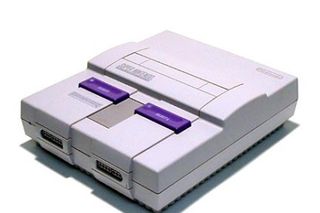Changing roms
Learn how to marry the majesty of your PC to classic games by emulating
The renaissance: 16-bit era
SNES
It’s fairly easy to dig up SNES ROMs for it (usually in the .smc format) if you’re used to finding dodgy stuff from the web. Setting up multiplayer can be a little trickier. In theory it's no more difficult than each player knowing the other's IP address and typing it into the box in Netplay > Connect, but you may have to fiddle with your router settings. To play strangers you'll need another app: zbattle (see zbattle.net).
Getit working
1) ZSNES is only about 1Mb - just extract it to a folder wherever you please, click on ZSNES.exe and that's it, it’s good to go. To make matters easier in the future, it’s worth right clicking on one of your SNES ROMs (they usually end with .smc), choosing “open with” then browsing to the zsnes.exe. From now on, double clicking a ROM should automatically open it in ZSNES. It's not like you'd want to open it anywhere else.
2) The first place to go is the Config menu, and then Video. Choosing a screen resolution is straightforward enough, but the higher you go the worse these old games will look. A lower-res monitor or even a TV can be a better bet. Otherwise, click the “filters” tab and experiment with which one makes the games look best: HQ is the most advanced, but sometimes Scan lines can have a better effect.
3) The most important other configuration menu to poke around in on ZSNES is that of Input. While SNES games are perfectly playable on a keyboard, a gamepad is a better bet. Click “set keys” and ZSNES will then ask you to tap a preferred button for each SNES pad switch being emulated, one by one. The #2-5 tabs let you choose keys for extra pads (for shared-screen multiplay, or just to give you alternatives).
4) And now to actually play something. It’s worth having a look in the other config menus, but crucial keys to remember are F2 and F4, which are quicksave and quickload respectively. F3 will choose which save slot you use, so you can have multiple restores to choose from. It’s also worth defining a fast forward key in the config speed menu, as it’ll help you skip past those interminably boring Nintendo cutscenes.
Sign up to the 12DOVE Newsletter
Weekly digests, tales from the communities you love, and more
The renaissance: 16-bit era
SNES
It’s fairly easy to dig up SNES ROMs for it (usually in the .smc format) if you’re used to finding dodgy stuff from the web. Setting up multiplayer can be a little trickier. In theory it's no more difficult than each player knowing the other's IP address and typing it into the box in Netplay > Connect, but you may have to fiddle with your router settings. To play strangers you'll need another app: zbattle (see zbattle.net).
Getit working
1) ZSNES is only about 1Mb - just extract it to a folder wherever you please, click on ZSNES.exe and that's it, it’s good to go. To make matters easier in the future, it’s worth right clicking on one of your SNES ROMs (they usually end with .smc), choosing “open with” then browsing to the zsnes.exe. From now on, double clicking a ROM should automatically open it in ZSNES. It's not like you'd want to open it anywhere else.
2) The first place to go is the Config menu, and then Video. Choosing a screen resolution is straightforward enough, but the higher you go the worse these old games will look. A lower-res monitor or even a TV can be a better bet. Otherwise, click the “filters” tab and experiment with which one makes the games look best: HQ is the most advanced, but sometimes Scan lines can have a better effect.
3) The most important other configuration menu to poke around in on ZSNES is that of Input. While SNES games are perfectly playable on a keyboard, a gamepad is a better bet. Click “set keys” and ZSNES will then ask you to tap a preferred button for each SNES pad switch being emulated, one by one. The #2-5 tabs let you choose keys for extra pads (for shared-screen multiplay, or just to give you alternatives).
4) And now to actually play something. It’s worth having a look in the other config menus, but crucial keys to remember are F2 and F4, which are quicksave and quickload respectively. F3 will choose which save slot you use, so you can have multiple restores to choose from. It’s also worth defining a fast forward key in the config speed menu, as it’ll help you skip past those interminably boring Nintendo cutscenes.

Above: SNES emulators come standard with an anti-yellowing agent
Essential games
Super Mario World
It’s big, challenging, visually gorgeous and filled with secrets. Using quicksave feels like cheating, but takes a lot of the repetition-through-death pain out of it.
The Legend of Zelda: A Link to the Past
Arguably better than Ocarina of Time on the N64. Certainly there's a simplicity and sense of meticulous design to this action-RPG-platform-puzzler. If anything, it defines the Nintendo approach to 16-bit gaming better than SMW.
Chrono Trigger
From the makers of Final Fantasy, this is widely considered the SNES’s best RPG. It’s not as restrictive as the FF games - there are multiple endings, character-specific sidequests and the ability to visit parts of the world at different periods in time. Also, a robot called Robo.
F-Zero
Super Mario Kart is for sissies. The original F-Zero was the first SNES game to use Mode 7, a rendering mode that created a sort of pseudo-3D, but that’s not why it remains compelling (in fact, it looks pretty awful now). It’s incredibly fast, all too easy to destroy your car and full of ingeniously nasty tricks.
Most Popular



